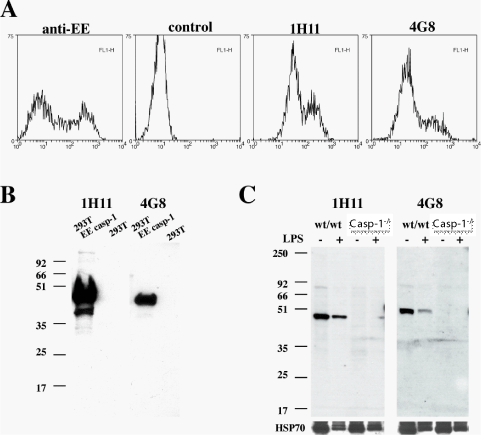Product Details
| Alternative Name: | IL-1β converting enzyme, Interleukin-1β converting enzyme, ICE |
| |
| Clone: | 4G8 |
| |
| Host: | Rat |
| |
| Isotype: | IgG1 |
| |
| Immunogen: | p20 fragment of mouse caspase-1 and synthetic peptide corresponding to aa 206-220 (T206ALEMVKEVKEFAAC220) of mouse caspase-1. |
| |
| UniProt ID: | P29452 |
| |
| Species reactivity: | Mouse
|
| |
| Specificity: | Recognizes an epitope within the p20 fragment of caspase-1. |
| |
| Crossreactivity: | Does not cross-react with mouse caspase-11 or -12. |
| |
| Applications: | ELISA, Flow Cytometry, WB
|
| |
| Application Notes: | Detects a band of ~45kDa by Western blot. |
| |
| Formulation: | Liquid. Protein G Sepharose™ purified antibody in PBS containing 0.02% sodium azide. |
| |
| Shipping: | Blue Ice |
| |
| Short Term Storage: | +4°C |
| |
| Long Term Storage: | -20°C |
| |
| Scientific Background: | Capases are a highly conserved family of cysteine proteases and are synthesized as inactive zymogens, which are cleaved at Asp-x sites during apoptosis, generating large and small subunits that heterodimerize to form the active enzyme. Caspase-1 is a member of the ICE/CED-3 family of caspases and is detected in the pro-form as a protein of 45 kDa.
Caspase-1 generates the bioactive form of the pro-inflammatory cytokine IL-1β from its biologically inactive precursor. Overexpression of caspase-1 in cells induces apoptosis, which can be inhibited by cytokine response modifier A (CrmA). Caspase-1 mRNA is predominantly expressed in the spleen and lung and to a lesser extent in skeletal muscle, kidney, testis and heart and within these tissues macrophages preferentially express caspase-1. Caspase-1 deficient mice have no gross abnormalities, however, macrophages from caspase-1-deficient mice are defective in IL-β processing and release. |
| |
| Technical Info/Product Notes: | SEPHAROSE is a trademark of GE Healthcare companies. |
| |
| Regulatory Status: | RUO - Research Use Only |
| |

Figure A: MAbs to caspase-1 (clone 1H11 (
Prod.No. ALX-804-530) and clone 4G8 (
Prod. No. ALX-804-531)) detect overexpressed caspase-1 in 293T cells transiently transfected with an EE tagged inactive cysteine mutant of mouse caspase-1 by flow cytometry.
Figure B: MAbs to caspase-1 (clone 1H11 (
Prod.No. ALX-804-530) and clone 4G8 (
Prod. No. ALX-804-531)) detect overexpressed caspase-1 in 293T cells transiently transfected with a EE tagged inactive cysteine mutant of mouse caspase-1 as a band of ~45 kDa.
Figure C: MAbs to caspase-1 (clone 1H11 (
Prod.No. ALX-804-530) and clone 4G8 (
Prod. No. ALX-804-531)) detect endogenous pro-caspase-1 in spleen from WT mice, but not from spleen of caspase-1 deficient mice. HSP-70: loading control. "
Please mouse over
Product Literature References
Amyloid-beta oligomerization is associated with the generation of a typical peptide fragment fingerprint: N. Rudinskiy, et al.; Alzheimers Dement.
12, 996 (2016),
Application(s): SDS-PAGE and immunoblotting,
Abstract;
General Literature References
Caspase-2 is not required for thymocyte or neuronal apoptosis even though cleavage of caspase-2 is dependent on both Apaf-1 and caspase-9: L.A. O'Reilly, et al.; Cell Death Differ.
9, 832 (2002), Methodology,
Abstract;
Rapid hybridoma screening method for the identification of monoclonal antibodies to low-abundance cytoplasmic proteins: L.A. O'Reilly, et al.; Biotechniques
25, 824 (1998), Methodology,
Abstract;










